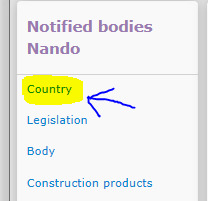What is the CE Mark?
The CE mark appears on many products that are traded withing the European Economic Area (EEA).
This means that;
- The product has been tested and meets EU health, safety and environmental guidelines.
- The product complies with EU legislation.
- The product is allowed free movement to be traded within the EEA
If you are a manufacturer it is your responsibility to:
- carry out the conformity assessment
- set up the technical file
- issue the EC Declaration of Conformity (DoC)
- place CE marking on a product
 If you are a distributor you must check the presence of both the CE marking and the necessary supporting documentation.
If you are a distributor you must check the presence of both the CE marking and the necessary supporting documentation.If you are importing a product that is from a third country you have to check that the manufacturer outside the EU has undertaken the necessary steps. You must check that the documentation is available.
(source GOV.co.uk 2017)
(img news.dengeki.com)
What products need a CE mark?
Not everything needs a CE mark.
Here is a list of the things that may affect us as crafters
- appliances burning gaseous fuels
- low voltage machinery and electrical equipment (Lamps, Fairy lights etc).
- measuring instruments (measuring jugs, scales etc).
- personal protective equipment (personal alarms, stun torches etc).
- Toys
CE testing is NOT required for
- Cosmetics. Covered by the Cosmetic Products (Safety) Regulations 2008.
- Foodstuffs. Covered by the Food Standards Act 1999.
- Furniture and furnishings Including blankets and pillows. Covered by the Furniture and Furnishings (Fire) (Safety) Regulations 1988
Getting your products certified
YOU CAN SELF CERTIFY YOUR PRODUCTS!
Here is a link to an fantastic article by Vicki Gregory on how she went about self certifying her own toys.
IF you need to find a company who can do conformity testing for you....
Use this link to take you to the NANDO (New Approach Notified and Designated Organisations) home page.
On the left click "Country"
Then find the country you will be certifying your product in.
Click the down arrow to the right of the dropdown menu.....
....and select the piece of legislation that applies.
This will take you to an up to date list of organisations that are certified to carry out the testing
So what is a conformity assessment?
Conformity assessment involves a set of processes that show your product, service or system meets the requirements of a standard.
Undergoing the conformity assessment process has a number of benefits:
- It provides consumers and other stakeholders with added confidence.
- It gives your company a competitive edge.
- It helps regulators ensure that health, safety or environmental conditions are met.
(source iso.org)
A large part of this will be a risk assessment. This identifies all the possible risks that a product could cause against the likelihood of that risk happening.
There is a link to a risk assessment template you can use HERE
What needs to be in the technical file(TF)?
Depending on the directive applying to the product, different requirements apply to what is needed in the technical file. Here is a rough guide as to what you should include in your TF;
- Description of the apparatus, usually accompanied by block diagram
- Wiring and circuit diagrams (if applicable)
- General Arrangement drawing
- List of standards applied
- Records of risk assessments and assessments to standards
- Description of control philosophy/logic (why it will be used)
- Datasheets for critical sub-assemblies (If applicable)
- Part list
- Copies of any markings and labels
- Copy of instructions (user, maintenance, installation)
- Test reports
- Quality control & commissioning procedures
- Certificate of conformity
How do I issue an EC Declaration of Conformity (DoC)?
An EC Doc is just a legal document that you sign to confirm that you have conformed to all of the directives regarding your product.
Use THIS template for your DoC.
Where do I place the CE mark?
Where you place the CE mark depends on what you are making. Fundamentally it needs to be "clear and non removable"
In general you should attach the CE marking to the product itself but it may also be placed on the packaging, in manuals and on other supporting literature. Rules covering the use of the CE markings vary depending on the specific EU directive that applies to the product and it is advisable to study the applicable guidance. The following general rules all apply:
- CE markings must only be placed by you - as the manufacturer - or your authorised representative
- the CE marking cannot be placed on products which are not covered by the relevant European directives
- when attaching the CE marking, you take full responsibility for your product’s conformity with the requirements of the relevant directives
- you must only use the CE marking to show the product’s conformity with the relevant directives
- you must not place any marking or sign that may misconstrue the meaning or form of the CE marking to third parties
- other markings placed on the product must not cover up the CE marking
(source GOV.co.uk)
unfortunately there is no straightforward answer to this question. It depends on how much you do yourself or if you outsource your testing.
Here is a LINK to an article that I found quite interesting on the subject of CE pricing.
Case study
Here is another link to Vicki Gregory's article on how she went about CE testing toys for her Folksy business.







Hi fellas,
ReplyDeleteThank you so much for this wonderful article really!
If someone want to read more about that EU authorised Representative I think this is the right place for you!